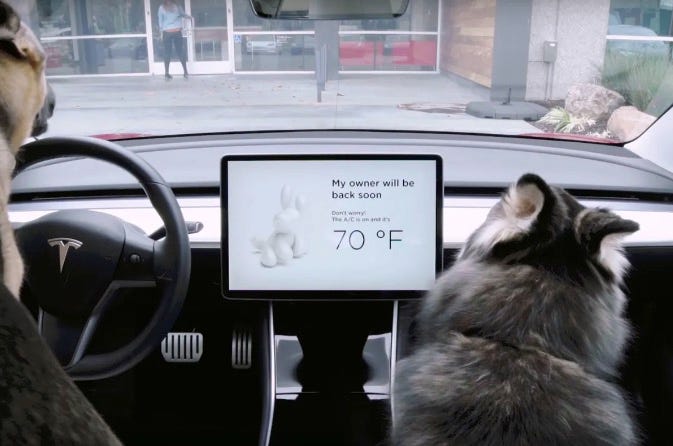Why your dog may be happier in an EV, plus EU's new green deal is coming
And wood burning stoves may be last big pollutant
This column is for Callaway Climate Insights subscribers only, but it’s OK to share once in a while. Was it shared with you? Please subscribe.
This smoky money-saver could be the last big pollutant
Growing up in England, we lived on a small farm. My dad, a rural-living lover, was a weekend warrior on the place and commuted to London to pursue his real job.
The place was picturesque — a 17th century brick-and-flint house surrounded by agriculturally focused buildings, including a barn that was listed as architecturally important by the government. But, heck, did the house leak energy, leading my parents to install a wood-burning stove that used spare timber from our land.
We didn’t think at all about the smoke coming out of the chimney — hey, it was the ‘70s. In fact, it seemed in a way that we were being green by using renewable fuel.
And now increasing numbers of fellow Brits are creating a wood-burning wave of sorts, with the U.K. Department for Environment, Food and Rural Affairs (DEFRA) pointing out that, like my family, it has become an upper-middle class practice, with about half of the stoves bought by people in the upper AB social/economic grades.
“There is certainly a concern that we are creating new air pollution hotspots, including in more affluent areas, where people do not think of their environment as being polluted,” Gary Fuller, of the school of public health at Imperial College London, told The Guardian.
“My inbox is already full of people who are breathing wood smoke from their neighbors. These are typically people who care for someone else and are worried about the smoke filling the bedroom of their asthmatic child or elderly relative.”
Meanwhile in the U.S., where wood is more available and cheaper, pollution from stoves is an even greater issue. In 2015, for example, the Energy Information Administration (IEA) reported that 12.5 million homes used wood for heat, producing about 6% of fine particulate emissions. The problem is particularly large in the west, with conurbations such as Denver often experiencing severe, wood-smelling smogs.
Yup, you can introduce all the EVs, solar panels and wind turbines you want, but until people are encouraged to shun wood by exceptionally low electricity prices from renewables, it could be one of the last notable pollutants.
Time to log out.
Why the EU’s ponderous ways might be better for a green future
For about a decade I lived under the auspices of the European Union. The UK, where I was born and bred, joined in 1973 and I moved to the U.S. in 1982. Overall, I thought it was a good thing, but, like many Britons — as evidenced in part by Britain’s decision to leave the organization in 2020 — I was frustrated by Brussels’ ponderous bureaucracy. It seemed like everything took an age to get done and when it was completed that the rules and regulations were needlessly nit-picky.
Ah, I said when I reached America, decisions are made more quickly and there is more flexibility. Also, at that time, politics was a much more polite game and consensus could be reached reasonably easily.
Not now. The polarization of U.S. politics that has developed in the past 10 years or so has become poisonous — a them-against-us full-pitched battle for hearts and minds. And its effects are being fully felt in the sphere of tackling climate change. For instance, last week, Congressional Republicans introduced two resolutions — one from the House and one from the Senate — to overturn executive branch rule making on issues relating to the environment and rules established by the Labor Department and EPA.
The first, to be sponsored by Indiana’s Sen. Mike Braun and Kentucky’s Rep. Andy Barr, would overturn the Department of Labor’s rule making to allow finance firms to take environmental, social and governance — or ESG — factors into consideration when choosing retirement investments, reports E&E News. The resolution, championed by West Virginia’s Sen. Shelley Moore and Rep. Sam Graves, would permanently repeal the Biden administration’s waters of the U.S. — or WOTUS — definition, arguing the regulation amounts to federal overreach that will burden businesses and farmers.
And then there are questions as to what would happen to the climate-focused Inflation Reduction Act should the GOP take over the presidency and Congress in 2024. And more.
Contrast that with the 27 countries of the EU. You can be certain that Europe’s just-announced $270 billion Green Industrial Plan — a direct pushback at President Joe Biden’s Inflation Reduction Act — will stay the course when, as is likely, it is approved by EU leaders in coming weeks, meaning that a steady flow of tax breaks and other incentives will go to businesses investing in net-zero technologies.
Unless things change on Capitol Hill, the U.S. will continue to fall behind Europe — and the increasingly looming American nemesis, China — in the race to renewables.
This dogs-in-EVs study is barking mad
I’ve always loved watching dogs riding in vehicles — sticking their heads out of windows or standing on the back of a pickup truck with broad smiles on their faces as they watch the world go by. Or there are the ones spread out peacefully on the passenger seats.
And those were Fidos in fossil-fueled vehicles. Now, a British study says they could be even happier by riding in an EV rather than a conventionally powered auto.
Yup, scientists at the University of Lincoln, in research commissioned by CarGurus.com, took 20 dogs on 10-minute drives, first in an EV and then in a diesel car, before a range of scientific observations and biometric measurements were made, according to a media release. They were given an hour break between the trips to ensure they were relaxed for both and were also filmed using a GoPro camera to identify any behaviors that indicated discomfort or relaxation. (Cuteness alert! See the video here.)
Led by Daniel Mills, professor of veterinary behavioral medicine at the university, it was found that dogs were less settled in diesel-powered cars compared with EVs, with pooches breaking their laying position on average 50% more in the fossil fuel vehicle. Mills and his team also found 39% of the four-legged passengers settled better, 43% were calmer, 42% seemed less anxious and 45% whined less in the EV. Additionally, canines that showed some signs of car sickness had notably reduced symptoms in the all-electric auto.
“We know most dogs will travel in a car at some point in their life, if not on a daily basis,” Mills said, and “our results clearly show that dogs seem to be more relaxed in EVs, particularly when looking at behavioral traits such as restlessness.”
Said Chris Knapman, of CarGurus UK: “For those who regard the switch to an electric car as a good fit, this study will provide reassurance that it'll suit their dog equally as well.”
You might even want a new name for your EV-loving canine companion. How about Elon Mutt?
Mail in your food scraps? Let’s do the math.
Food waste. It’s a huge problem. It takes a lot of emissions to produce food — step forward, belching cows — and then leftovers rot in landfills, producing huge amounts of ultra-damaging methane. Overall, according to the World Food Program, about a third of food produced goes uneaten.
At my childhood home in England, we were, fortunately, a waste-free family when it came to food. First, having parents who had grown up during the rationing of World War 2, virtually nothing was allowed to be left on our plates. Second, we had animals who were happy to eat the byproducts of cooking — the bones and excess fat went to the sheepdogs and the chickens and geese liked to peck away at things like cauliflower leaves and apple peelings.
So, talking of chicken feed, it seemed, on the face of it, a good idea when I read about an American startup called Mill that promises to turn your food scraps into chicken feed.
Here’s how it works: Mill sends its members a high-tech trash can for their leftovers. The electronic bin then turns those leftovers into food grounds. Finally, members mail those grounds to Mill, which uses it to make chicken feed.
OK, sounds good. And the fledgling has secured funding from big-name backers, including Bill Gates’ Breakthrough Energy Ventures, Chris Sacca’s Lowercarbon Capital, Prelude Ventures and California venture capitalist John Doerr.
But, it seems to me, the carbon costs of the system could outweigh the benefits. First, mailing something produces considerable pollution. There’s the van that picks up the parcel and the truck that takes it cross-country. Then there’s the packaging: a cardboard box lined with a plastic bag — pollution alert! — that needs to be taped up (second pollution alert!).
Next, there’s that high-tech bin. It’s made of plastic (pollution alert!). And it has a power cord that delivers electricity to the device as it “dries, shrinks and de-stinks your kitchen scraps overnight,” according to a press release. Pollution alert!
And then there’s the cost. Membership is $33 a month paid annually or $45 for month-to-month payments that cover the cost of the bin, charcoal filters, ground shipping and an app to track your impact. Not chump change, for sure.
Mill says it has done the arithmetic on its environmental benefits and the system comes out ahead.
I wouldn’t bet on this one.
(A native of England, veteran journalist Matthew Diebel has worked at NBC News, Time, USA Today and News Corp., among other organizations. Having spent much of his childhood next to one of the world's fastest bodies of water, he is particularly interested in tidal energy.)


